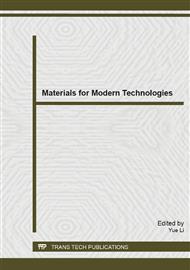[1]
M. N. Zafar, I. Abbas, R. Nadeem, M. A. Sheikh, M. A. Ghauri, Removal of nickel onto alkali treated rice bran, Water, Air, and Soil Pollution. 197 (2008) 361-370.
DOI: 10.1007/s11270-008-9817-6
Google Scholar
[2]
M. Zhao, J. R. Duncan, R. P. van Hille, Removal and recovery of zinc from solution and electroplating effluent using Azolla filiculoides, Water Research, 33 (1999) 1516-1522.
DOI: 10.1016/s0043-1354(98)00338-8
Google Scholar
[3]
R. H. Crist, K. Oberholser, N. Shank, N. Ming, Nature of bonding between metallic ions and algal cell walls, Environmental Science & Technology. 15 (1981) 1212-1217.
DOI: 10.1021/es00092a010
Google Scholar
[4]
M. H. Nasir, R. Nadeem, K. Akhtar, M. A. Hanif, A. M. Khalid, Efficacy of modified distillation sludge of rose (Rosa centifolia) petals for lead(II) and zinc(II) removal from aqueous solutions, Journal of Hazardous Materials. 147 (2007) 1006-1014.
DOI: 10.1016/j.jhazmat.2007.01.131
Google Scholar
[5]
M. J. Jimenez-Cedillo, M. T. Olguin, C. Fall, A. Colin-Cruz, As(III) and As(V) sorption on iron-modified non-pyrolyzed and pyrolyzed biomass from Petroselinum crispum (parsley), Journal of Environmental Management. 117 (2013) 242-52.
DOI: 10.1016/j.jenvman.2012.12.023
Google Scholar
[6]
G. P. Gerola, N. V. Boas, J. Caetano, C. R. T. Tarley, A. C. Gonçalves, D. C. Dragunski, Utilization of passion fruit skin by-product as lead(II) ion biosorbent, Water, Air, & Soil Pollution, 224 (2013).
DOI: 10.1007/s11270-013-1446-z
Google Scholar
[7]
C. S. Goh, K. T. Tan, K. T. Lee, S. Bhatia, Bio-ethanol from lignocellulose: Status, perspectives and challenges in Malaysia, Bioresource Technology. 101 (2010) 4834-4841.
DOI: 10.1016/j.biortech.2009.08.080
Google Scholar
[8]
M. Sciban, J. Prodanovic, R. Razmovski, Biosorption of copper(II) and chromium(VI) by modified tea fungus, Acta Periodica Technologica, 43 (2012) 335-342.
DOI: 10.2298/apt1243335s
Google Scholar
[9]
R. Kumar, N. R. Bishnoi, Garima, K. Bishnoi, Biosorption of chromium(VI) from aqueous solution and electroplating wastewater using fungal biomass, Chemical Engineering Journal. 135 (2008) 202-208.
DOI: 10.1016/j.cej.2007.03.004
Google Scholar
[10]
M. A. -G. Saleh, M. G. Khaled, S. B. Abdulaziz, Biosorption characteristics of Aspergillus fumigatus in removal of cadmium from an aqueous solution, African Journal of Biotechnology. 10 (2009) 4163-4172.
Google Scholar
[11]
F. Abnisa, A. Arami-Niya, W. M. A. W. Daud, J. N. Sahu, Characterization of Bio-oil and bio-char from pyrolysis of palm oil wastes, BioEnergy Research. 6 (2013) 830-840.
DOI: 10.1007/s12155-013-9313-8
Google Scholar
[12]
Y. Lu, S. Li, L. Guo, Hydrogen production by supercritical water gasification of glucose with Ni/CeO2/Al2O3: Effect of Ce loading, Fuel. 103 (2013)193-199.
DOI: 10.1016/j.fuel.2012.04.038
Google Scholar
[13]
I. Kiran, T. Akar, S. Tunali, Biosorption of Pb(II) and Cu(II) from aqueous solutions by pretreated biomass of Neurospora crassa, Process Biochemistry. 40 (2005) 3550-3558.
DOI: 10.1016/j.procbio.2005.03.051
Google Scholar
[14]
T. R. Muraleedharan, C. Venkobachar, Mechanism of biosorption of copper(II) by Ganoderma iucidum, Biotechnology and Bioengineering. 35 (1990) 320-325.
DOI: 10.1002/bit.260350314
Google Scholar
[15]
M. Loaëc, R. Olier, J. Guezennec, Uptake of lead, cadmium and zinc by a novel bacterial exopolysaccharide, Water Research. 31 (1997) 1171-1179.
DOI: 10.1016/s0043-1354(96)00375-2
Google Scholar
[16]
S. Saygideger, O. Gulnaz, E. S. Istifli, N. Yucel, Adsorption of Cd(II), Cu(II) and Ni(II) ions by Lemna minor L.: Effect of physicochemical environment, J. of Hazardous Materials, vol. 126 (2005) 96-104.
DOI: 10.1016/j.jhazmat.2005.06.012
Google Scholar
[17]
G. Yan, T. Viraraghavan, Effect of pretreatment on the bioadsorption of heavy metals on Mucor rouxii, Water SA. 26 (2000) 119-123.
Google Scholar


